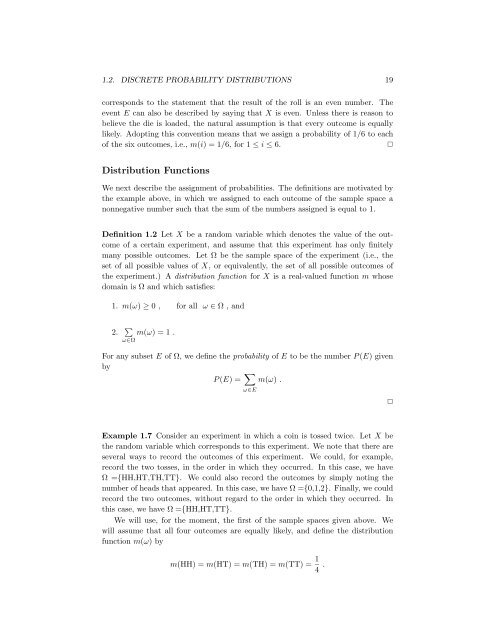Chapter 1 Discrete Probability Distributions - DIM
Chapter 1 Discrete Probability Distributions - DIM
Chapter 1 Discrete Probability Distributions - DIM
- No tags were found...
You also want an ePaper? Increase the reach of your titles
YUMPU automatically turns print PDFs into web optimized ePapers that Google loves.
1.2. DISCRETE PROBABILITY DISTRIBUTIONS 19corresponds to the statement that the result of the roll is an even number. Theevent E can also be described by saying that X is even. Unless there is reason tobelieve the die is loaded, the natural assumption is that every outcome is equallylikely. Adopting this convention means that we assign a probability of 1/6 to eachof the six outcomes, i.e., m(i) =1/6, for 1 ≤ i ≤ 6.✷Distribution FunctionsWe next describe the assignment of probabilities. The definitions are motivated bythe example above, in which we assigned to each outcome of the sample space anonnegative number such that the sum of the numbers assigned is equal to 1.Definition 1.2 Let X be a random variable which denotes the value of the outcomeof a certain experiment, and assume that this experiment has only finitelymany possible outcomes. Let Ω be the sample space of the experiment (i.e., theset of all possible values of X, or equivalently, the set of all possible outcomes ofthe experiment.) A distribution function for X is a real-valued function m whosedomain is Ω and which satisfies:1. m(ω) ≥ 0 , for all ω ∈ Ω , and2.∑ω∈Ωm(ω) =1.For any subset E of Ω, we define the probability of E to be the number P (E) givenbyP (E) =ω∈Em(ω).∑✷Example 1.7 Consider an experiment in which a coin is tossed twice. Let X bethe random variable which corresponds to this experiment. We note that there areseveral ways to record the outcomes of this experiment. We could, for example,record the two tosses, in the order in which they occurred. In this case, we haveΩ={HH,HT,TH,TT}. We could also record the outcomes by simply noting thenumber of heads that appeared. In this case, we have Ω ={0,1,2}. Finally, we couldrecord the two outcomes, without regard to the order in which they occurred. Inthis case, we have Ω ={HH,HT,TT}.We will use, for the moment, the first of the sample spaces given above. Wewill assume that all four outcomes are equally likely, and define the distributionfunction m(ω) bym(HH) = m(HT) = m(TH) = m(TT) = 1 4 .
















